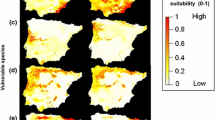Abstract
LIAS gtm, a new platform of the LIAS lichen information system, is presented. It allows for the visualization of phenotypic traits via geographic heatmapping of relative trait frequencies (RTFs) based on data derived from GBIF (occurrence data) and from LIAS light (taxon description data). The data are combined and referred to defined geographic areas of interest. Exemplarily, LIAS gtm provides distribution patterns of a selection of single, dual or multiple traits. The data are visualized for two lichen record hotspots, Scandinavia and Australia. Detailed technical information is provided on the platform web site itself.





Similar content being viewed by others
References
Cocchietto M, Skert N, Nimis PL, Sava G (2002) A review on usnic acid, an interesting natural compound. Naturwissenschaften 89:137–146
Elix J. A., Kalb K., Rupprecht J., Schobert R (2016) [last visited: 2016-03-28]. LIAS metabolites—A database for the rapid identification of secondary metabolites of lichens (Rambold G, ed.),.http://liaslight.lias.net/Identification/Navikey/Metabolites
Hauck M, Jürgens S-R, Leuschner Ch (2010) Norstictic acid: correlations between its physico-chemical characteristics and ecological preferences of lichens producing this depsidone. Environ Exp Bot 68(3):309–313. doi:10.1016/j.envexpbot.2010.01.003
Ingólfsdóttir K (2002) Molecules of interest. Usnic acid. Phytochemistry 61(7):729–736
Peršoh D, Beck A, Rambold G (2004) The distribution of ascus types and photobiontal selection in Lecanoromycetes (Ascomycota) against the background of a revised SSU nrDNA phylogeny. Mycological Progress 3(2):103–121
Rambold G. (lead editor; for detailed information see http://liaslight.lias.net/About/Impressum.html and http://liasnames.lias.net/About/Impressum.html) 2016 [last visited: 2016-03-28]. LIAS: A global information system for lichenized and non-lichenized ascomycetes (version Dec 2015). In: species 2000 & ITIS catalogue of life, 25th March 2016 (Roskov Y., Abucay L., Orrell T., Nicolson D., Kunze T., Flann C., Bailly N., Kirk P., Bourgoin T., DeWalt R.E., Decock W., De Wever A., eds.), http://www.catalogueoflife.org/col. Species 2000: Naturalis, Leiden, The Netherlands. ISSN 2405-8858
Rambold G, Elix JA, Heindl-Tenhunen B, Köhler T, Nash THIII, Neubacher D, Reichert W, Zedda L, Triebel D (2014) LIAS light—Towards the ten thousand species milestone. MycoKeys 8:11–16. doi:10.3897/mycokeys.8.6605
Triebel D., Bensch K (2016) [last visited: 2016-03-01]. LIAS names—A database with names of lichens, lichenicolous fungi and non-lichenized ascomycetes, http://liasnames.lias.net
Wikipedia contributors. 2016 [last visited: 2016-03-28]. ‘Köppen climate classification’, wikipedia, the free encyclopedia, https://en.wikipedia.org/w/index.php?title=K%C3%B6ppen_climate_classification&oldid=712316931
Zedda L, Rambold G (2015). The diversity of lichenised fungi: ecosystem functions and ecosystem services. Recent Adv Lichenol: 122–140
Author information
Authors and Affiliations
Corresponding author
Additional information
Communicated by T.G. Allan Green.
This article belongs to the Topical Collection: Forest and plantation biodiversity.
Rights and permissions
About this article
Cite this article
Rambold, G., Zedda, L., Coyle, J.R. et al. Geographic heat maps of lichen traits derived by combining LIAS light description and GBIF occurrence data, provided on a new platform. Biodivers Conserv 25, 2743–2751 (2016). https://doi.org/10.1007/s10531-016-1199-2
Received:
Revised:
Accepted:
Published:
Issue Date:
DOI: https://doi.org/10.1007/s10531-016-1199-2




